air condition MERCEDES-BENZ M-Class 2014 W166 Owner's Manual
[x] Cancel search | Manufacturer: MERCEDES-BENZ, Model Year: 2014, Model line: M-Class, Model: MERCEDES-BENZ M-Class 2014 W166Pages: 462, PDF Size: 6.23 MB
Page 6 of 462
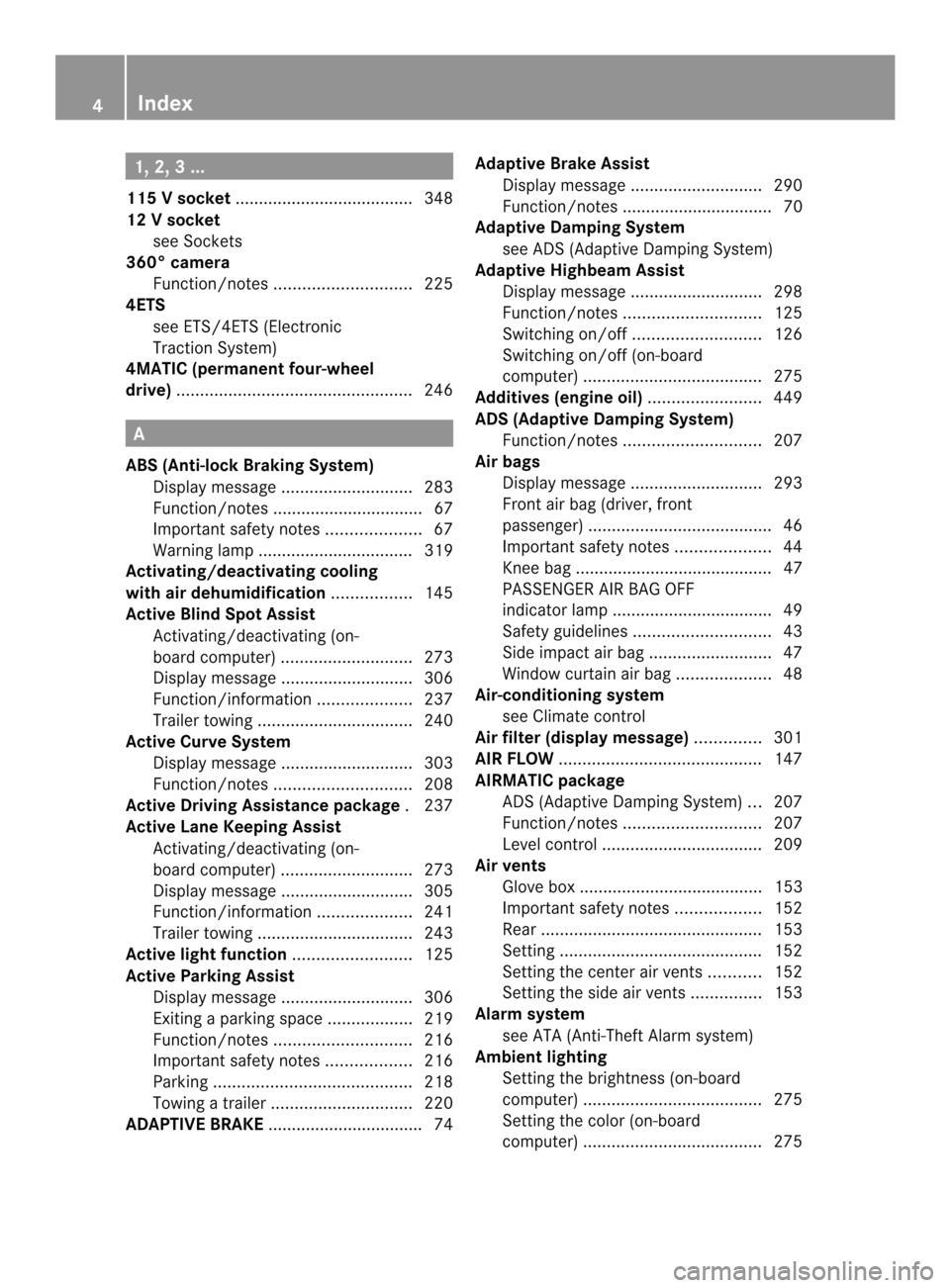
1, 2, 3 ...
115 Vsocket ...................................... 348
12 Vsocket
see Sockets
360° camera
Function/notes ............................. 225
4ETS
see ETS/4ETS (Electronic
Traction System)
4MATIC (permanent four-wheel
drive) .................................................. 246A
ABS (Anti-lock Braking System) Display message ............................ 283
Function/notes ................................ 67
Important safety notes ....................67
Warning lamp ................................. 319
Activating/deactivating cooling
with air dehumidification .................145
Active Blin dSpot Assist
Activating/deactivating (on-
board computer) ............................ 273
Display message ............................ 306
Function/informatio n.................... 237
Trailer towing ................................. 240
Active Curve System
Display message ............................ 303
Function/notes ............................. 208
Active Driving Assistance package .237
Active Lane Keeping Assist Activating/deactivating (on-
board computer) ............................ 273
Display message ............................ 305
Function/informatio n.................... 241
Trailer towing ................................. 243
Active light function .........................125
Active Parking Assist Display message ............................ 306
Exiting aparking spac e.................. 219
Function/notes ............................. 216
Important safety notes ..................216
Parking .......................................... 218
Towing atrailer .............................. 220
ADAPTIVE BRAKE ................................. 74 Adaptive Brake Assist
Display message ............................ 290
Function/notes ................................ 70
Adaptive Damping System
see ADS (Adaptive Damping System)
Adaptive Highbeam Assist
Display message ............................ 298
Function/notes ............................. 125
Switching on/off ........................... 126
Switching on/off (on-board
computer) ...................................... 275
Additives (engine oil) ........................449
ADS (Adaptive Damping System) Function/notes ............................. 207
Airb ags
Display message ............................ 293
Front air bag (driver, front
passenger )....................................... 46
Important safety notes ....................44
Knee bag .......................................... 47
PASSENGER AIR BAG OFF
indicator lamp .................................. 49
Safety guidelines ............................. 43
Side impact airb ag.......................... 47
Windo wcurtain air bag .................... 48
Air-conditioning system
see Climate control
Airf ilter (display message) ..............301
AIRF LOW ........................................... 147
AIRMATIC package ADS (Adaptive Damping System) ...207
Function/notes ............................. 207
Level control .................................. 209
Airv ents
Glove box ....................................... 153
Important safet ynotes .................. 152
Rea r............................................... 153
Setting ........................................... 152
Setting the center air vents ...........152
Setting the side air vents ...............153
Alarm system
see ATA (Anti-Theft Alarm system)
Ambient lighting
Setting the brightness (on-board
computer) ...................................... 275
Setting the color (on-board
computer) ...................................... 2754
Index
Page 18 of 462
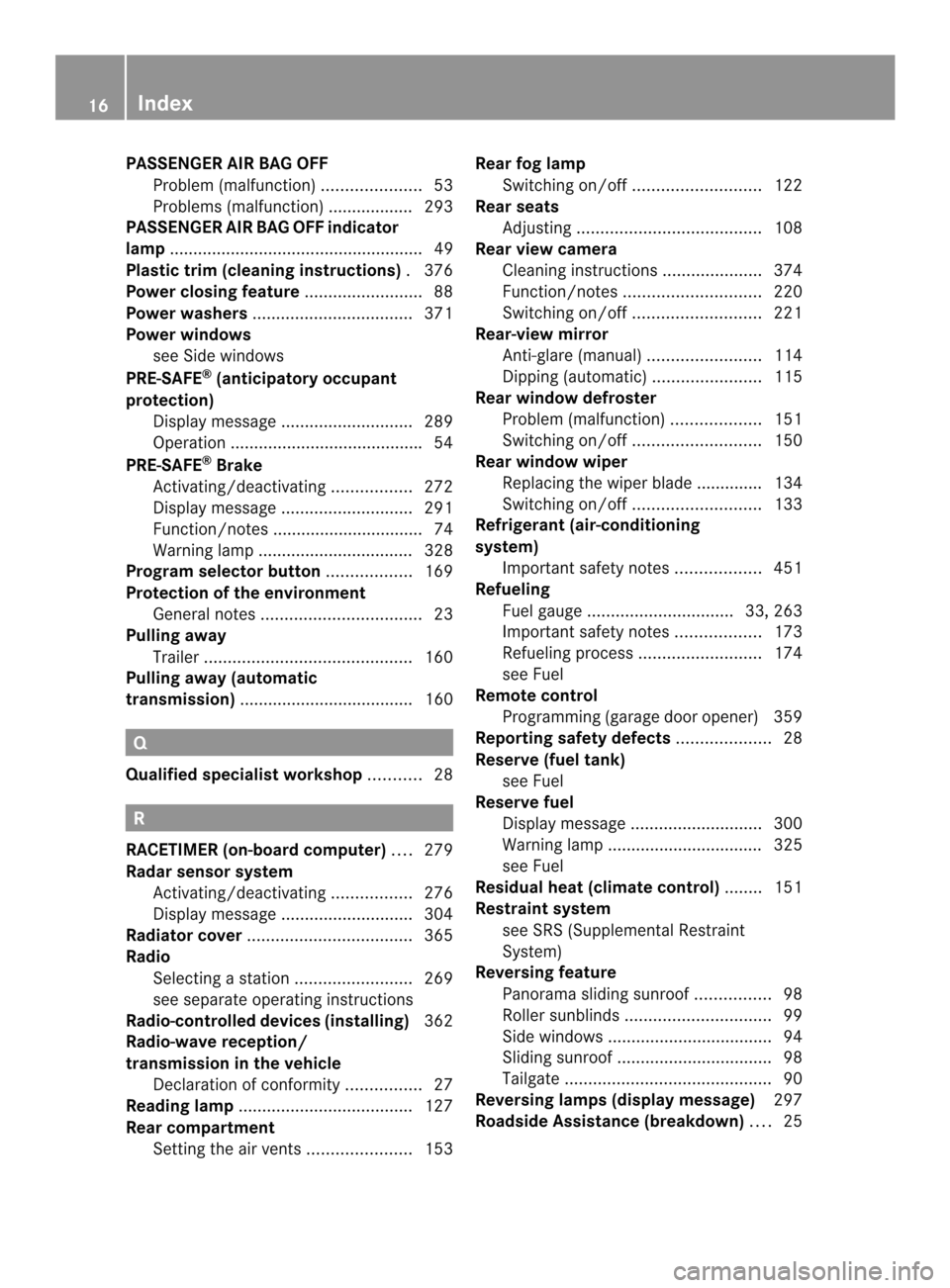
PASSENGER AIR BAG OFF
Problem (malfunction) .....................53
Problems (malfunction) .................. 293
PASSENGE RAIR BAG OFF indicator
lamp ...................................................... 49
Plastic trim (cleaning instructions) .376
Power closing feature .........................88
Power washers .................................. 371
Power windows see Side windows
PRE-SAFE ®
(anticipatory occupant
protection) Display message ............................ 289
Operation ........................................ .54
PRE-SAFE ®
Brake
Activating/deactivating .................272
Display message ............................ 291
Function/notes ................................ 74
Warning lamp ................................. 328
Program selector button ..................169
Protection of the environment General notes .................................. 23
Pulling away
Trailer ............................................ 160
Pulling away (automatic
transmission) ..................................... 160 Q
Qualifie dspecialis tworkshop ...........28 R
RACETIMER (on-board computer) ....279
Radar sensor system Activating/deactivating .................276
Display message ............................ 304
Radiator cover ................................... 365
Radio Selecting astation ......................... 269
see separate operating instructions
Radio-controlled devices (installing) 362
Radio-wave reception/
transmission in the vehicle
Declaratio nofconformity ................ 27
Reading lamp ..................................... 127
Rear compartment Setting the airv ents...................... 153Rear fog lamp
Switching on/off ........................... 122
Rear seats
Adjusting ....................................... 108
Rear view camera
Cleaning instructions .....................374
Function/notes ............................. 220
Switching on/off ........................... 221
Rear-view mirror
Anti-glare (manual )........................ 114
Dipping (automatic) .......................115
Rear window defroster
Problem (malfunction) ...................151
Switching on/off ........................... 150
Rear window wiper
Replacing the wiper blade .............. 134
Switching on/off ........................... 133
Refrigerant (air-conditioning
system)
Important safety notes ..................451
Refueling
Fuel gauge ............................... 33, 263
Important safety notes ..................173
Refueling proces s.......................... 174
see Fuel
Remote control
Programming (garage door opener) 359
Reporting safety defects ....................28
Reserve (fuel tank) see Fuel
Reserve fuel
Display message ............................ 300
Warning lamp ................................. 325
see Fuel
Residual heat (climate control) ........151
Restraint system see SRS (Supplemental Restraint
System)
Reversing feature
Panorama sliding sunroo f................ 98
Roller sunblinds ............................... 99
Side windows ................................... 94
Sliding sunroo f................................. 98
Tailgate ............................................ 90
Reversing lamps (display message) 297
Roadside Assistance (breakdown) ....25 16
Index
Page 19 of 462
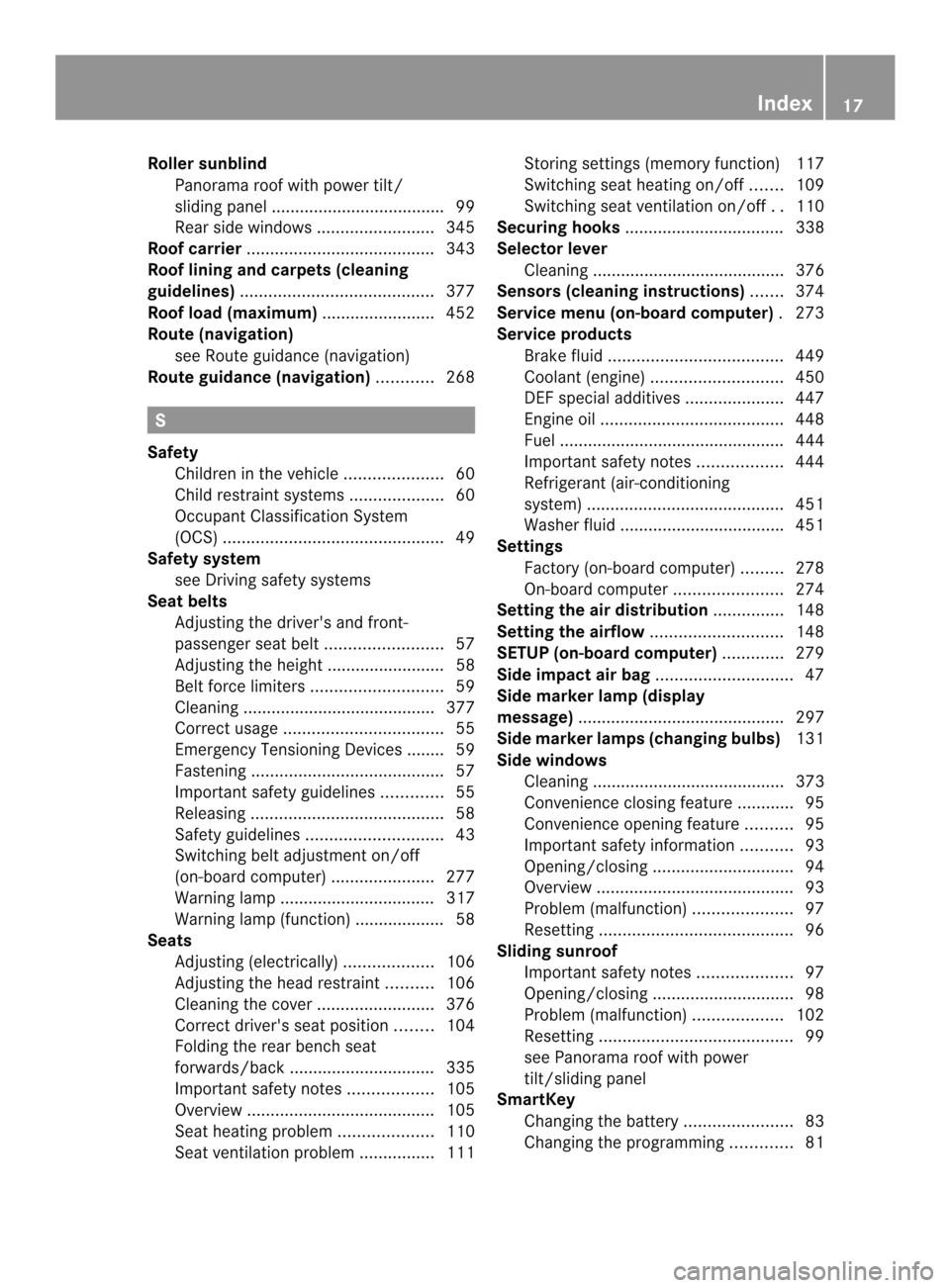
Rolle
rsunblind
Panorama roof with power tilt/
sliding panel .................................... .99
Rear side windows .........................345
Roof carrier ........................................ 343
Roof lining and carpets (cleaning
guidelines) ......................................... 377
Roof load (maximum) ........................452
Route (navigation) see Route guidance (navigation)
Route guidance (navigation) ............268 S
Safety Childre ninthe vehicle ..................... 60
Child restraint systems ....................60
Occupant Classification System
(OCS) ............................................... 49
Safety system
see Driving safety systems
Seat belts
Adjusting the driver's and front-
passenger sea tbelt ......................... 57
Adjusting the height ......................... 58
Belt force limiters ............................ 59
Cleaning ......................................... 377
Correct usage .................................. 55
Emergency Tensioning Devices ....... .59
Fastening ......................................... 57
Important safety guidelines .............55
Releasing ......................................... 58
Safety guidelines ............................. 43
Switching belt adjustment on/off
(on-board computer) ......................277
Warning lamp ................................. 317
Warning lamp (function) ................... 58
Seats
Adjusting (electrically). ..................106
Adjusting the head restraint ..........106
Cleaning the cover .........................376
Correct driver's sea tposition ........104
Folding the rear bench seat
forwards/back ............................... 335
Important safety notes ..................105
Overview ........................................ 105
Seat heating problem ....................110
Seat ventilation problem ................111Storing settings (memory function) 117
Switching sea
theating on/off .......109
Switching seat ventilation on/off ..110
Securing hooks .................................. 338
Selector lever Cleaning ......................................... 376
Sensors (cleaning instructions) .......374
Service menu (on-board computer) .273
Service products Brake fluid ..................................... 449
Coolant (engine) ............................ 450
DEF special additive s..................... 447
Engine oil ....................................... 448
Fuel ................................................ 444
Important safety notes ..................444
Refrigerant (air-conditioning
system) .......................................... 451
Washer fluid .................................. .451
Settings
Factory (on-board computer) .........278
On-board computer .......................274
Setting the air distribution ...............148
Setting the airflow ............................148
SETUP (on-board computer) .............279
Side impact air bag .............................47
Side marker lamp (display
message) ............................................ 297
Side marker lamps (changing bulbs) 131
Side windows Cleaning ......................................... 373
Convenience closing feature ............95
Convenience opening feature ..........95
Important safety information ...........93
Opening/closing .............................. 94
Overview .......................................... 93
Problem (malfunction) .....................97
Resetting ......................................... 96
Sliding sunroof
Important safety notes ....................97
Opening/closing .............................. 98
Problem (malfunction) ...................102
Resetting ......................................... 99
see Panorama roof with power
tilt/sliding panel
SmartKey
Changing the battery .......................83
Changing the programming .............81 Index
17
Page 25 of 462
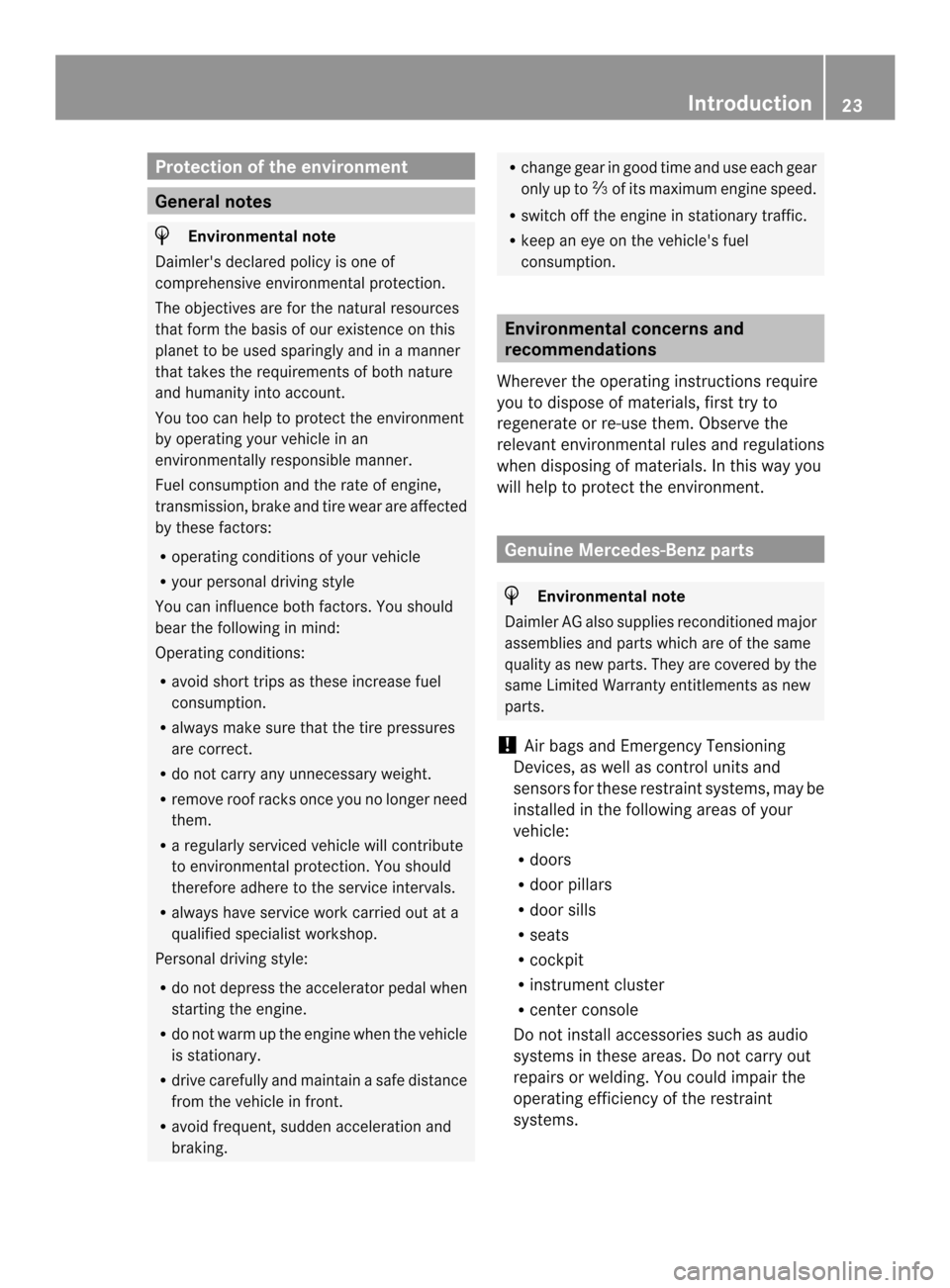
Protection of the environment
General notes
H
Environmental note
Daimler's declared policy is one of
comprehensive environmental protection.
The objectives are for the natural resources
that form the basis of our existence on this
planet to be used sparingly and in a manner
that takes the requirements of both nature
and humanity into account.
You too can help to protect the environment
by operating your vehicle in an
environmentally responsible manner.
Fuel consumption and the rate of engine,
transmission, brake and tire wear are affected
by these factors:
R operating conditions of your vehicle
R your personal driving style
You can influence both factors. You should
bear the following in mind:
Operating conditions:
R avoid short trips as these increase fuel
consumption.
R always make sure that the tire pressures
are correct.
R do not carry any unnecessary weight.
R remove roof racks once you no longer need
them.
R a regularly serviced vehicle will contribute
to environmental protection. You should
therefore adhere to the service intervals.
R always have service work carried out at a
qualified specialist workshop.
Personal driving style:
R do not depress the accelerator pedal when
starting the engine.
R do not warm up the engine when the vehicle
is stationary.
R drive carefully and maintain a safe distance
from the vehicle in front.
R avoid frequent, sudden acceleration and
braking. R
change gear in good time and use each gear
only up to 0001of its maximum engine speed.
R switch off the engine in stationary traffic.
R keep an eye on the vehicle's fuel
consumption. Environmental concerns and
recommendations
Wherever the operating instructions require
you to dispose of materials, first try to
regenerate or re-use them. Observe the
relevant environmental rules and regulations
when disposing of materials. In this way you
will help to protect the environment. Genuine Mercedes-Benz parts
H
Environmental note
Daimler AG also supplies reconditioned major
assemblies and parts which are of the same
quality as new parts. They are covered by the
same Limited Warranty entitlements as new
parts.
! Air bags and Emergency Tensioning
Devices, as well as control units and
sensors for these restraint systems, may be
installed in the following areas of your
vehicle:
R doors
R door pillars
R door sills
R seats
R cockpit
R instrument cluster
R center console
Do not install accessories such as audio
systems in these areas. Do not carry out
repairs or welding. You could impair the
operating efficiency of the restraint
systems. Introduction
23 Z
Page 27 of 462
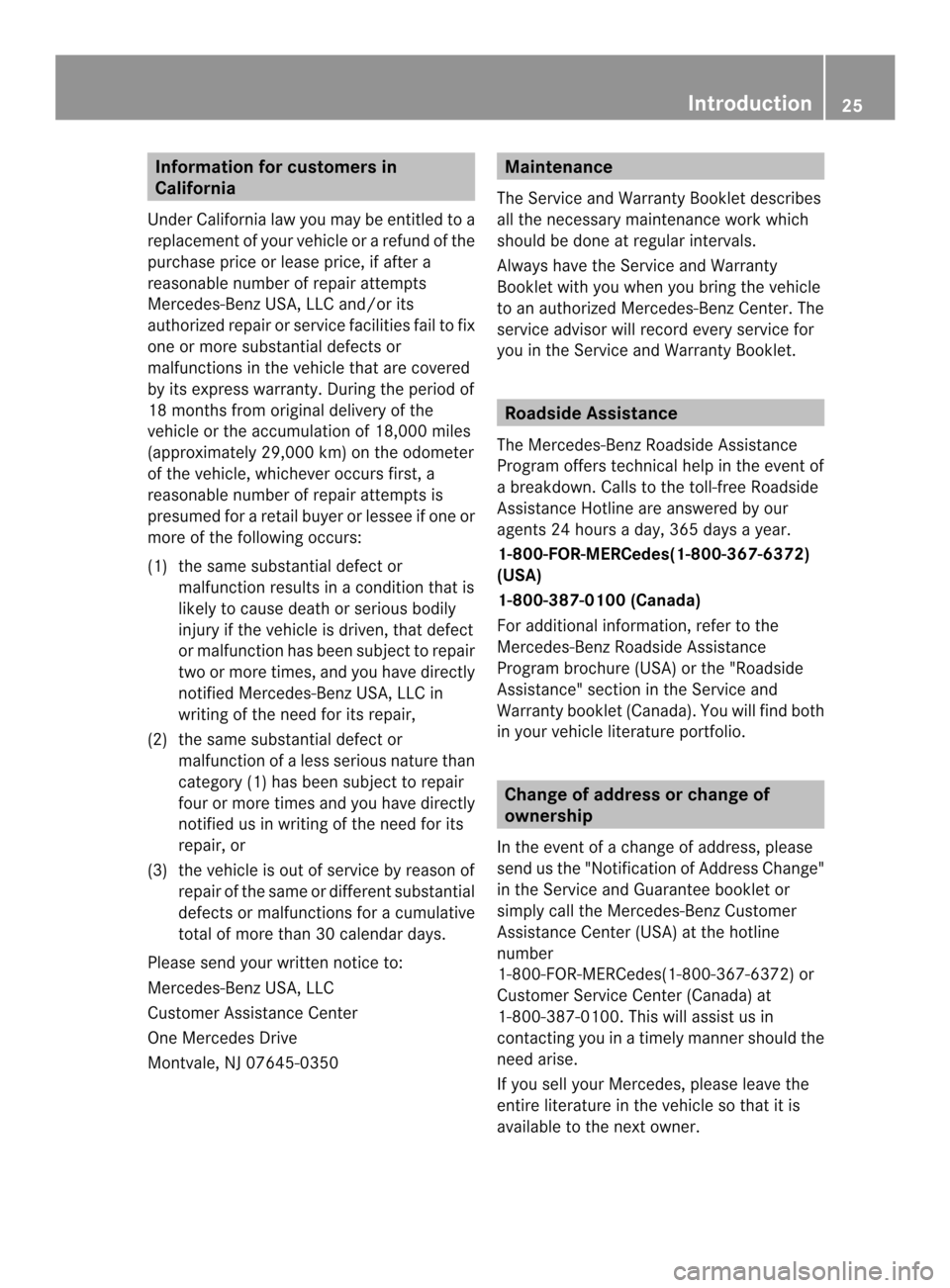
Information for customers in
California
Under California law you may be entitled to a
replacemen tofyour vehicle or a refund of the
purchase price or lease price, if after a
reasonable number of repair attempts
Mercedes-Benz USA, LLC and/or its
authorized repair or service facilities fail to fix
one or more substantial defects or
malfunctions in the vehicle that are covered
by its express warranty. During the period of
18 months from original delivery of the
vehicle or the accumulation of 18,000 miles
(approximately 29,000 km) on the odometer
of the vehicle, whichever occurs first, a
reasonable number of repair attempts is
presumed for a retail buyer or lessee if one or
more of the following occurs:
(1) the same substantial defect or malfunction results in a condition that is
likely to cause death or serious bodily
injury if the vehicle is driven, that defect
or malfunction has been subject to repair
two or more times, and you have directly
notified Mercedes-Benz USA, LLC in
writing of the need for its repair,
(2) the same substantial defect or malfunction of a less serious nature than
category (1) has been subject to repair
four or more times and you have directly
notified us in writing of the need for its
repair, or
(3) the vehicle is out of service by reason of repair of the same or different substantial
defects or malfunctions for a cumulative
total of more than 30 calendar days.
Please send your written notice to:
Mercedes-Benz USA, LLC
Customer Assistance Center
One Mercedes Drive
Montvale, NJ 07645-0350 Maintenance
The Service and Warranty Booklet describes
all the necessary maintenance work which
should be done at regular intervals.
Always have the Service and Warranty
Booklet with you when you bring the vehicle
to an authorized Mercedes-Benz Center. The
service advisor will record every service for
you in the Service and Warranty Booklet. Roadside Assistance
The Mercedes-Benz Roadside Assistance
Program offers technical help in the event of
a breakdown. Calls to the toll-free Roadside
Assistance Hotline are answered by our
agents 24 hours a day, 365 days a year.
1-800-FOR-MERCedes(1-800-367-6372)
(USA)
1-800-387-0100 (Canada)
For additional information, refer to the
Mercedes-Benz Roadside Assistance
Program brochure (USA) or the "Roadside
Assistance" section in the Service and
Warranty booklet (Canada) .You will find both
in your vehicle literature portfolio. Change of address or change of
ownership
In the event of a change of address, please
send us the "Notification of Address Change"
in the Service and Guarantee booklet or
simply call the Mercedes-Benz Customer
Assistance Center (USA) at the hotline
number
1-800-FOR-MERCedes(1-800-367-6372) or
Customer Service Center (Canada) at
1-800-387-0100. This will assist us in
contacting you in a timely manner should the
need arise.
If you sell your Mercedes, please leave the
entire literature in the vehicle so that it is
available to the next owner. Introduction
25 Z
Page 28 of 462
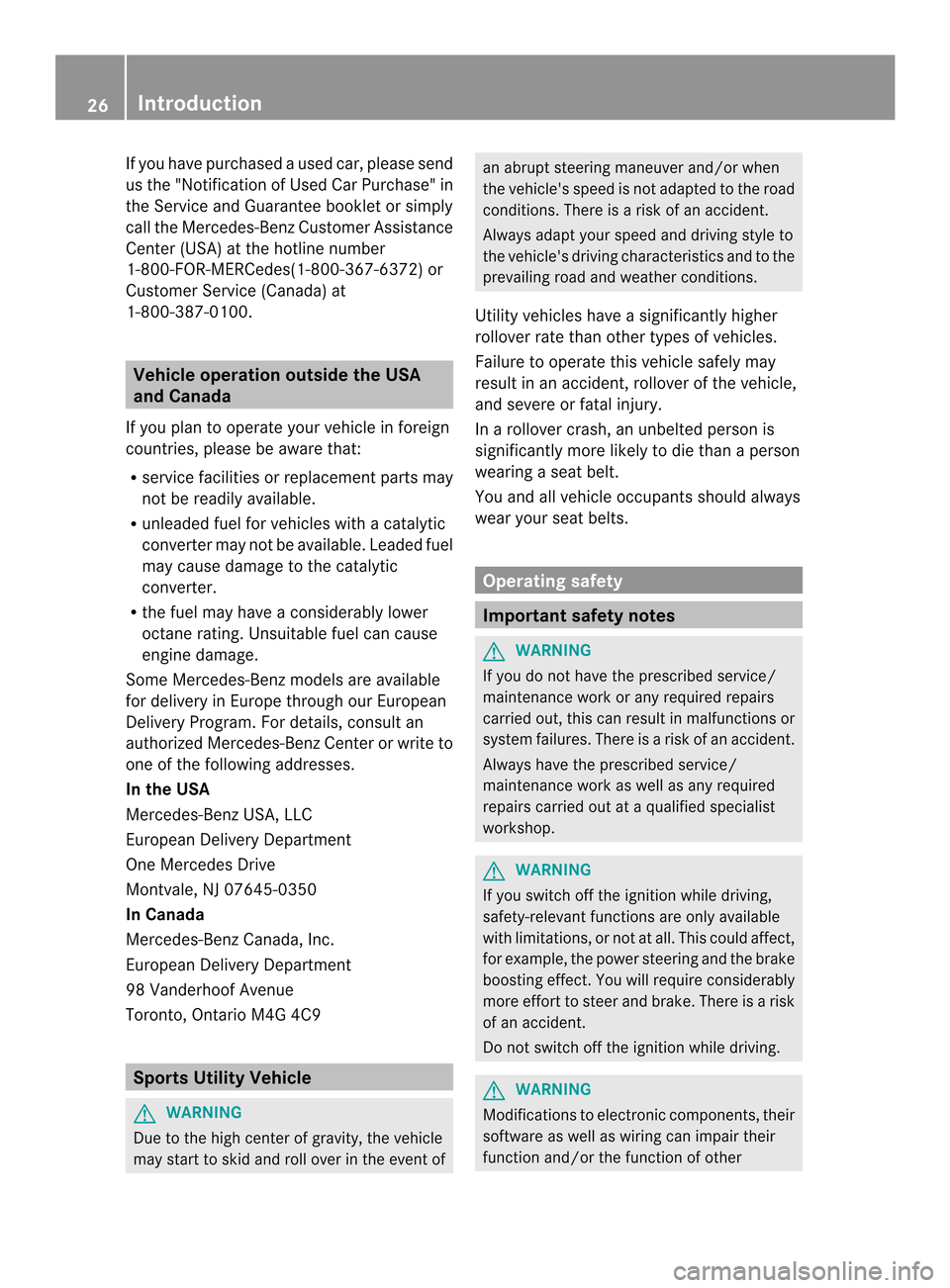
If you have purchased a used car, please send
us the "Notification of Used Car Purchase" in
the Service and Guarantee booklet or simply
call the Mercedes-Benz Customer Assistance
Center (USA) at the hotline number
1-800-FOR-MERCedes(1-800-367-6372) or
Customer Service (Canada) at
1-800-387-0100. Vehicle operation outside the USA
and Canada
If you plant o operate your vehicle in foreign
countries, please be aware that:
R service facilities or replacement parts may
not be readily available.
R unleaded fuel for vehicles with a catalytic
converter may not be available. Leaded fuel
may cause damage to the catalytic
converter.
R the fuel may have a considerably lower
octane rating. Unsuitable fuel can cause
engine damage.
Some Mercedes-Benz models are available
for delivery in Europe through our European
Delivery Program. For details, consult an
authorized Mercedes-Benz Center or write to
one of the following addresses.
In the USA
Mercedes-Benz USA, LLC
European Delivery Department
One Mercedes Drive
Montvale, NJ 07645-0350
In Canada
Mercedes-Benz Canada, Inc.
European Delivery Department
98 Vanderhoof Avenue
Toronto, Ontario M4G 4C9 Sports Utility Vehicle
G
WARNING
Due to the high center of gravity, the vehicle
may start to skid and roll over in the event of an abrupt steering maneuver and/or when
the vehicle's speed is not adapted to the road
conditions. There is a risk of an accident.
Always adapt your speed and driving style to
the vehicle's driving characteristics and to the
prevailing road and weather conditions.
Utility vehicles have a significantly higher
rollover rate than other types of vehicles.
Failure to operate this vehicle safely may
result in an accident, rollover of the vehicle,
and severe or fatal injury.
In a rollover crash, an unbelted person is
significantly more likely to die than a person
wearing a seat belt.
You and all vehicle occupant sshould always
wear your seat belts. Operating safety
Important safety notes
G
WARNING
If you do not have the prescribed service/
maintenance work or any required repairs
carried out, this can result in malfunctions or
system failures. There is a risk of an accident.
Always have the prescribed service/
maintenance work as well as any required
repairs carried out at a qualified specialist
workshop. G
WARNING
If you switch off the ignition while driving,
safety-relevant functions are only available
with limitations, or not at all. This could affect,
for example, the power steering and the brake
boosting effect.Y ou will require considerably
more effort to steer and brake. There is a risk
of an accident.
Do not switch off the ignition while driving. G
WARNING
Modifications to electronic components, their
software as well as wiring can impair their
function and/or the function of other 26
Introduction
Page 29 of 462
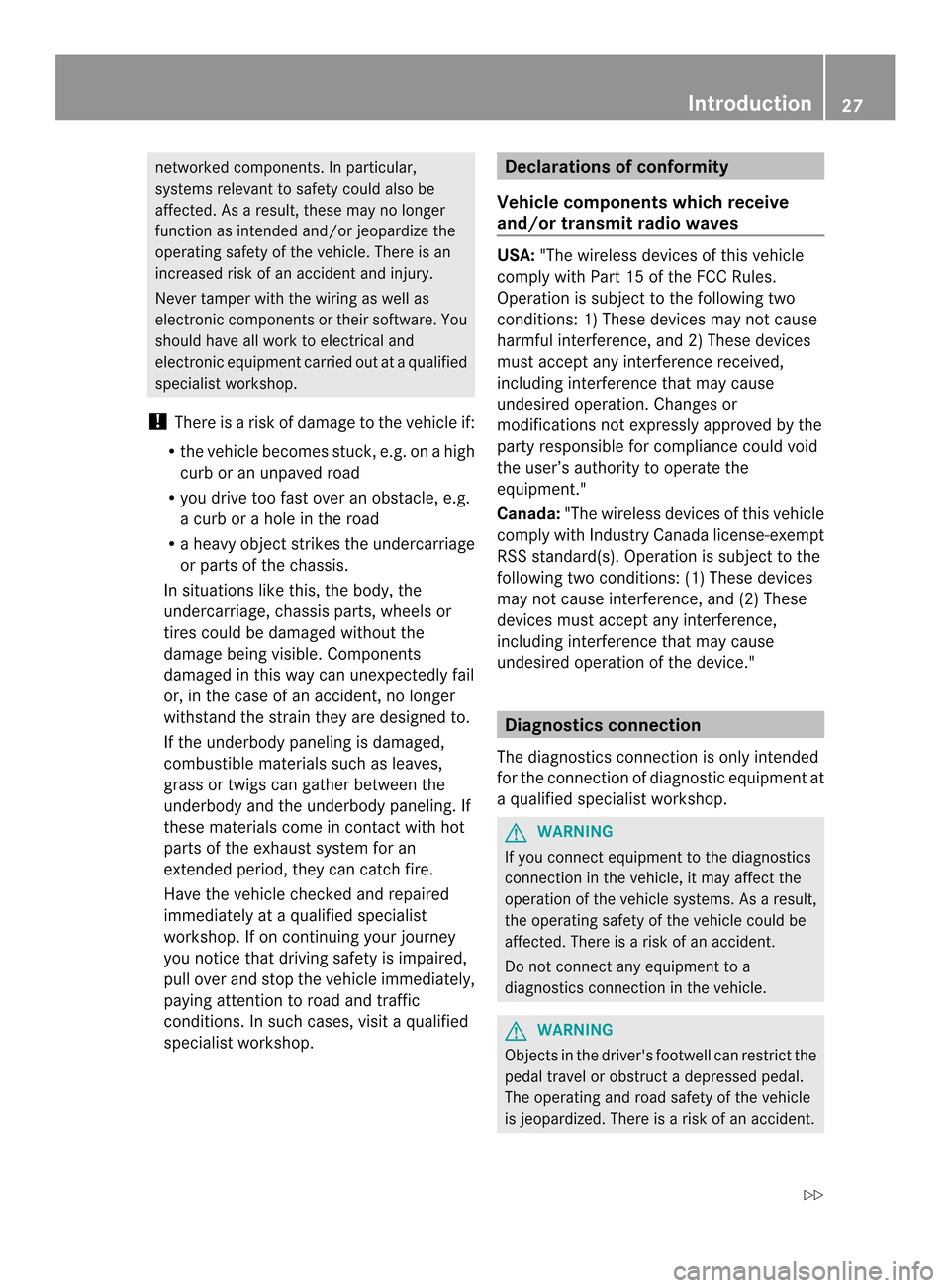
networked components. In particular,
systems relevant to safety could also be
affected. As a result, these may no longer
functio nas intended and/or jeopardize the
operating safety of the vehicle. There is an
increased risk of an accident and injury.
Never tamper with the wiring as well as
electronic components or their software. You
should have all work to electrical and
electronic equipment carried out at a qualified
specialist workshop.
! There is a risk of damage to the vehicle if:
R the vehicle becomes stuck, e.g. on a high
curb or an unpaved road
R you drive too fast over an obstacle, e.g.
a curb or a hole in the road
R a heavy object strikes the undercarriage
or parts of the chassis.
In situations like this, the body, the
undercarriage, chassis parts, wheels or
tires could be damaged without the
damage being visible. Components
damaged in this way can unexpectedly fail
or, in the case of an accident, no longer
withstand the strain they are designed to.
If the underbody paneling is damaged,
combustible materials such as leaves,
grass or twigs can gather between the
underbody and the underbody paneling. If
these materials come in contact with hot
parts of the exhaust system for an
extended period, they can catch fire.
Have the vehicle checked and repaired
immediately at a qualified specialist
workshop. If on continuing your journey
you notice that driving safety is impaired,
pull over and stop the vehicle immediately,
paying attention to road and traffic
conditions. In such cases, visit a qualified
specialist workshop. Declarations of conformity
Vehicle components which receive
and/or transmit radio waves USA:
"The wireless devices of this vehicle
comply with Part 15 of the FCC Rules.
Operation is subject to the following two
conditions: 1) These devices may not cause
harmful interference, and 2) These devices
must accept any interference received,
including interference that may cause
undesired operation. Changes or
modifications not expressly approved by the
party responsible for compliance could void
the user’s authority to operate the
equipment."
Canada: "The wireless devices of this vehicle
comply with Industry Canada license-exempt
RSS standard(s). Operation is subject to the
following two conditions: (1) These devices
may not cause interference, and (2) These
devices must accept any interference,
including interference that may cause
undesired operation of the device." Diagnostics connection
The diagnostics connection is only intended
for the connection of diagnostic equipment at
a qualified specialist workshop. G
WARNING
If you connect equipment to the diagnostics
connection in the vehicle, it may affect the
operation of the vehicle systems. As a result,
the operating safety of the vehicle could be
affected. There is a risk of an accident.
Do not connect any equipment to a
diagnostics connection in the vehicle. G
WARNING
Objects in the driver's footwell can restrict the
pedal travel or obstruct adepressed pedal.
The operating and road safety of the vehicle
is jeopardized. There is a risk of an accident. Introduction
27 Z
Page 31 of 462
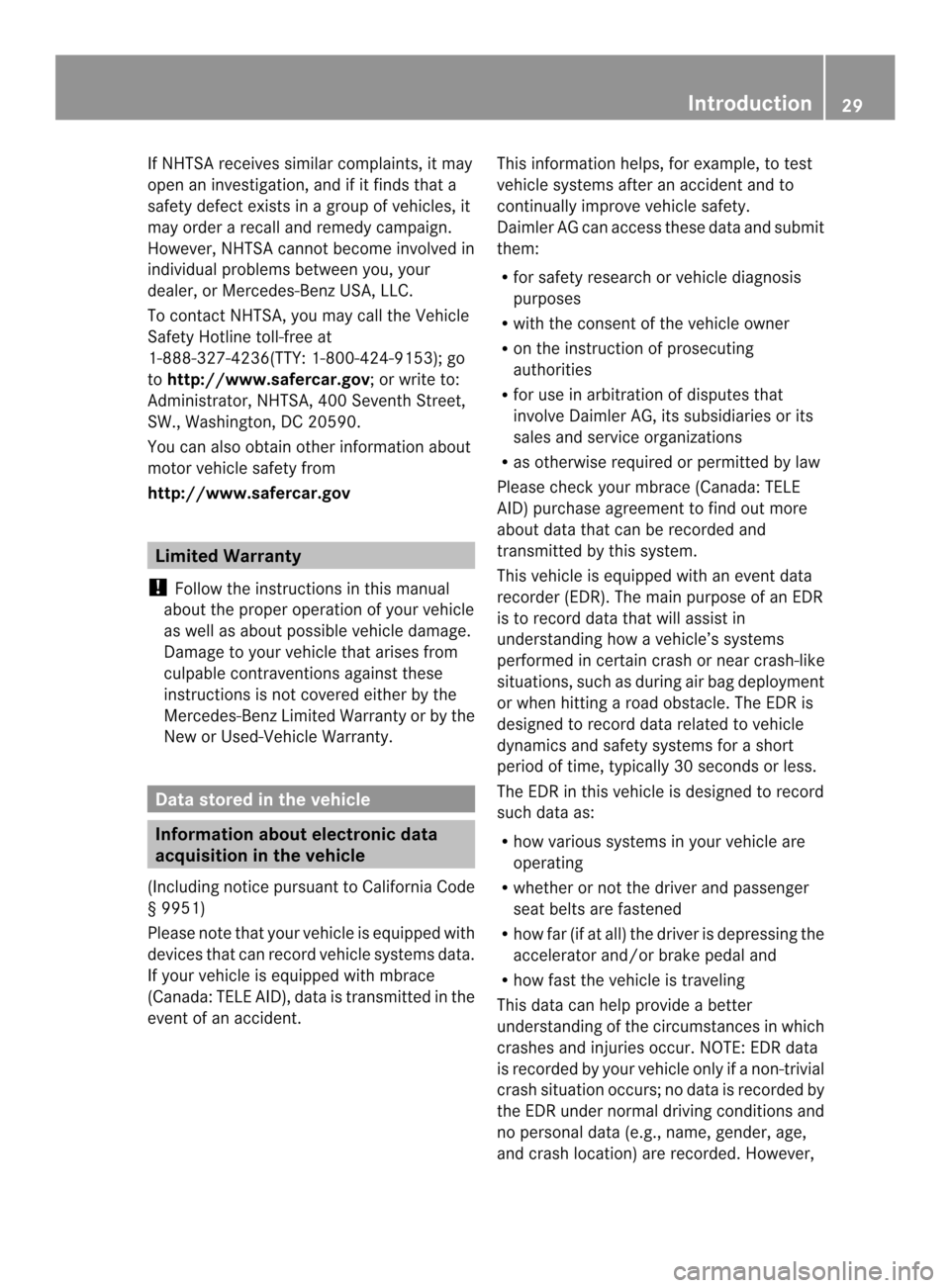
If NHTSA receives similar complaints, it may
open an investigation, and if it finds that a
safety defect exists in a group of vehicles, it
may order a recall and remedy campaign.
However, NHTSA cannot become involved in
individual problems betwee nyou, your
dealer, or Mercedes-Benz USA, LLC.
To contact NHTSA, you may call the Vehicle
Safety Hotline toll-free at
1-888-327-4236(TTY: 1-800-424-9153); go
to http://www.safercar.gov; or write to:
Administrator, NHTSA, 400 Seventh Street,
SW., Washington, DC 20590.
You can also obtain other information about
motor vehicle safety from
http://www.safercar.gov Limited Warranty
! Follow the instructions in this manual
about the proper operation of your vehicle
as well as about possible vehicle damage.
Damage to your vehicle that arises from
culpable contraventions against these
instructions is not covered either by the
Mercedes-Benz Limited Warranty or by the
New or Used-Vehicle Warranty. Data stored in the vehicle
Information about electronic data
acquisition in the vehicle
(Including notice pursuant to California Code
§ 9951)
Please note that your vehicle is equipped with
devices that can record vehicle systems data.
If your vehicle is equipped with mbrace
(Canada :TELE AID) ,data is transmitted in the
event of an accident. This informatio
nhelps, for example, to test
vehicle systems after an accident and to
continually improve vehicle safety.
Daimler AG can access these data and submit
them:
R for safety research or vehicle diagnosis
purposes
R with the consent of the vehicle owner
R on the instruction of prosecuting
authorities
R for use in arbitration of disputes that
involve Daimler AG, its subsidiaries or its
sales and service organizations
R as otherwise required or permitted by law
Please chec kyour mbrace (Canada: TELE
AID) purchase agreement to find out more
about data that can be recorded and
transmitted by this system.
This vehicle is equipped with an event data
recorder (EDR). The main purpose of an EDR
is to record data that will assist in
understanding how a vehicle’s systems
performed in certain crash or near crash-like
situations, such as during air bag deployment
or when hitting a road obstacle. The EDR is
designed to record data related to vehicle
dynamics and safety systems for a short
period of time, typically 30 seconds or less.
The EDR in this vehicle is designed to record
such data as:
R how various systems in your vehicle are
operating
R whether or not the driver and passenger
seat belts are fastened
R how far (if at all) the driver is depressing the
accelerator and/or brake pedal and
R how fast the vehicle is traveling
This data can help provide abetter
understanding of the circumstances in which
crashes and injuries occur. NOTE: EDR data
is recorded by your vehicle only if a non-trivial
crash situation occurs; no data is recorded by
the EDR under normal driving conditions and
no personal data (e.g., name, gender, age,
and crash location) are recorded. However, Introduction
29 Z
Page 56 of 462
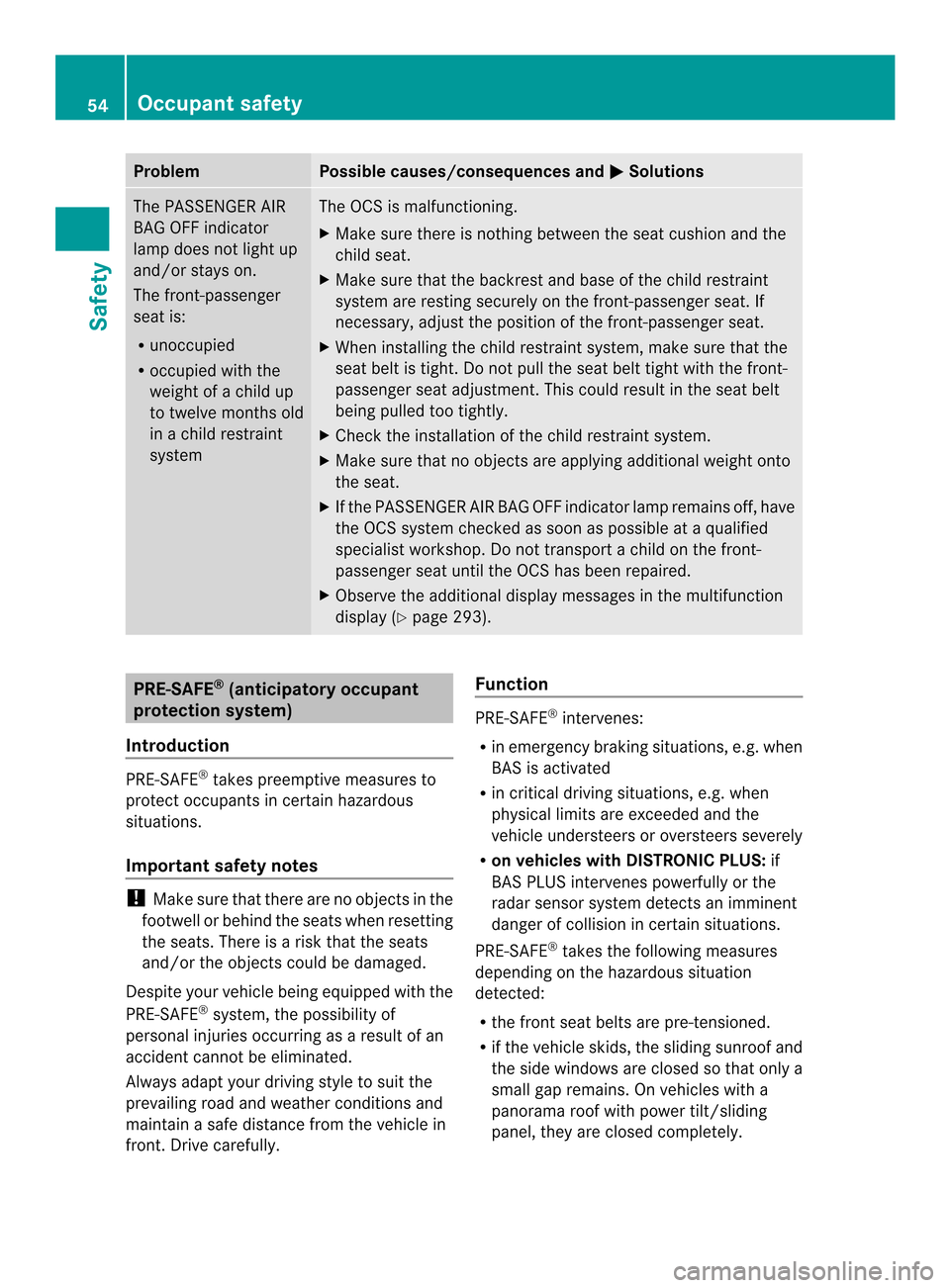
Problem Possible causes/consequences and
0001 Solutions
The PASSENGER AIR
BAG OFF indicator
lamp does not light up
and/or stays on.
The front-passenger
seat is:
R
unoccupied
R occupied with the
weight of a child up
to twelve months old
in a child restraint
system The OCS is malfunctioning.
X
Make sure there is nothing between the seat cushion and the
child seat.
X Make sure that the backrest and base of the child restraint
system are resting securely on the front-passenger seat. If
necessary, adjust the position of the front-passenger seat.
X When installing the child restraint system, make sure that the
seat belt is tight. Do not pull the seat belt tight with the front-
passenger seat adjustment .This could result in the seat belt
being pulled too tightly.
X Check the installation of the child restraint system.
X Make sure that no objectsa re applying additional weight onto
the seat.
X If the PASSENGER AIR BAG OFF indicator lamp remains off, have
the OCS system checked as soon as possible at a qualified
specialist workshop .Do not transport a child on the front-
passenger seat until the OCS has been repaired.
X Observe the additional display messages in the multifunction
display (Y page 293). PRE-SAFE
®
(anticipatory occupant
protection system)
Introduction PRE-SAFE
®
takes preemptive measures to
protect occupants in certain hazardous
situations.
Important safety notes !
Make sure that there are no objects in the
footwell or behind the seats when resetting
the seats. There is a risk that the seats
and/or the objects could be damaged.
Despite your vehicle being equipped with the
PRE-SAFE ®
system, the possibility of
personal injuries occurring as a result of an
accident cannot be eliminated.
Always adapt your driving style to suit the
prevailing road and weather conditions and
maintain a safe distance from the vehicle in
front. Drive carefully. Function PRE-SAFE
®
intervenes:
R in emergency braking situations, e.g. when
BAS is activated
R in critical driving situations, e.g. when
physical limits are exceeded and the
vehicle understeers or oversteers severely
R on vehicles with DISTRONIC PLUS: if
BAS PLUS intervenes powerfully or the
radar sensor system detect sanimminent
dange rofcollision in certain situations.
PRE-SAFE ®
takes the following measures
depending on the hazardous situation
detected:
R the front seat belts are pre-tensioned.
R if the vehicle skids, the sliding sunroof and
the side windows are closed so that only a
small gap remains. On vehicles with a
panorama roof with power tilt/sliding
panel, they are closed completely. 54
Occupant safetySafety
Page 69 of 462
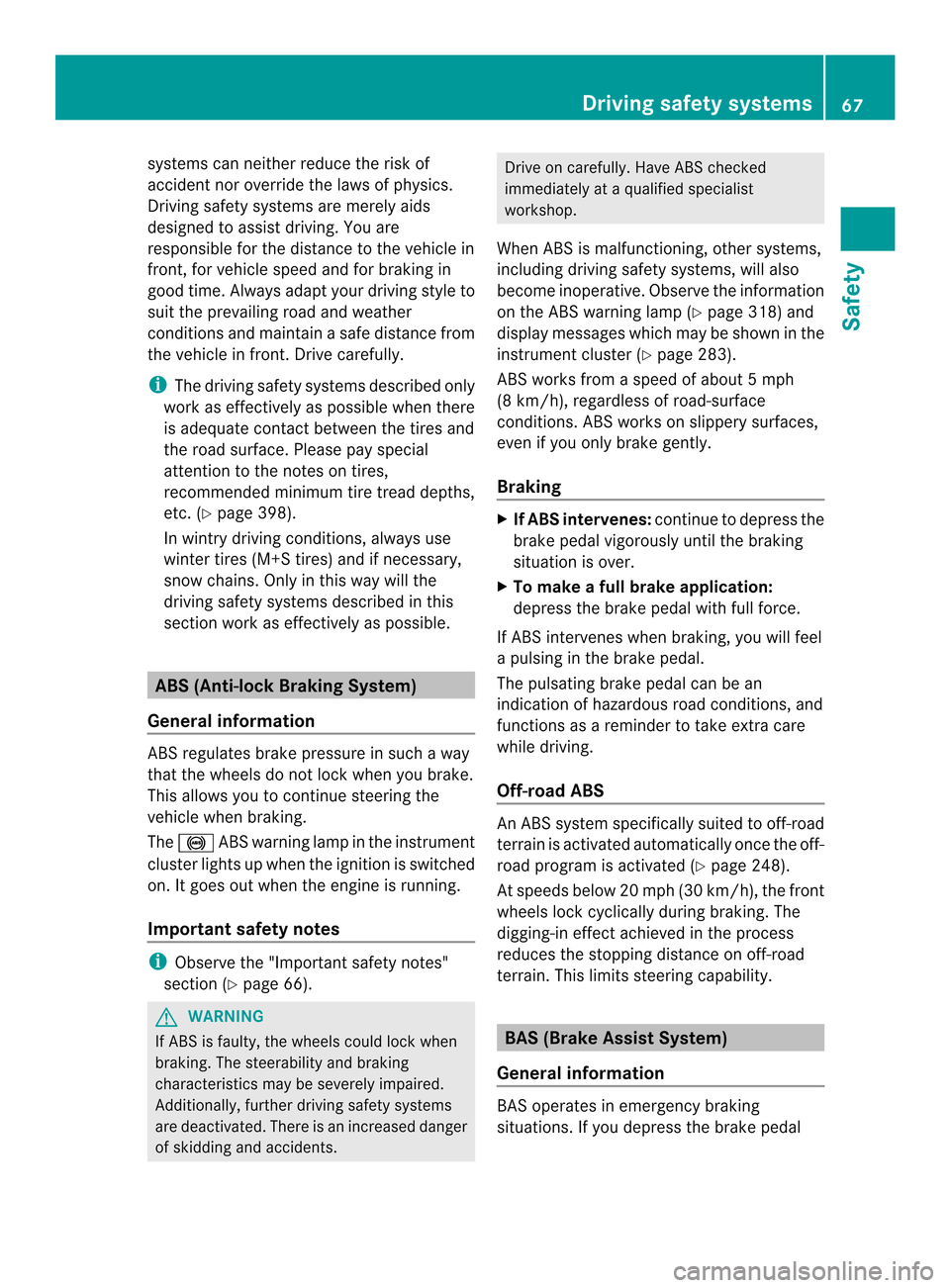
systems can neither reduce the risk of
accident nor override the laws of physics.
Driving safety systems are merely aids
designed to assist driving. You are
responsible for the distance to the vehicle in
front, for vehicle speed and for braking in
good time. Always adapty our driving style to
suit the prevailing road and weather
conditions and maintain asafe distance from
the vehicle in front. Drive carefully.
i The driving safety systems described only
work as effectively as possible when there
is adequate contact between the tires and
the road surface. Please pay special
attention to the note son tires,
recommended minimu mtire tread depths,
etc. (Y page 398).
In wintry driving conditions, always use
winter tires (M+S tires) and if necessary,
snow chains. Only in this way will the
driving safety systems described in this
section work as effectively as possible. ABS (Anti-lock Braking System)
General information AB
Sr egulates brake pressure in such a way
that the wheels do not lock when you brake.
This allows you to continue steering the
vehicle when braking.
The 0019 ABSw arning lamp in the instrument
cluste rlights up when the ignition is switched
on. It goes out when the engine is running.
Important safety notes i
Observe the "Importan tsafety notes"
sectio n(Ypage 66). G
WARNING
If ABSi s faulty, the wheels could lock when
braking. The steerability and braking
characteristics may be severely impaired.
Additionally, further driving safety systems
are deactivated. There is an increased danger
of skidding and accidents. Drive on carefully. Have ABS checked
immediately at a qualified specialist
workshop.
When ABS is malfunctioning, other systems,
including driving safety systems, will also
become inoperative. Observe the information
on the ABS warning lamp (Y page 318) and
display messages which may be shown in the
instrument cluster (Y page 283).
ABS works from a speed of about 5 mph
(8 km/h), regardless of road-surface
conditions. ABS works on slippery surfaces,
even if you only brake gently.
Braking X
If ABS intervenes: continue to depress the
brake pedal vigorously until the braking
situation is over.
X To make a full brake application:
depress the brake pedal with full force.
If ABS intervenes when braking, you will feel
a pulsing in the brake pedal.
The pulsating brake pedal can be an
indication of hazardous road conditions, and
functions as a reminder to take extra care
while driving.
Off-road ABS An ABS system specifically suited to off-road
terrain is activated automatically once the off-
road program is activated (Y
page 248).
At speeds below 20 mph (30 km/h), the front
wheels lock cyclically during braking. The
digging-in effect achieved in the process
reduces the stopping distance on off-road
terrain. This limits steering capability. BAS (Brake AssistS
ystem)
General information BAS operates in emergency braking
situations. If you depress the brake pedal Driving safety systems
67Safety Z